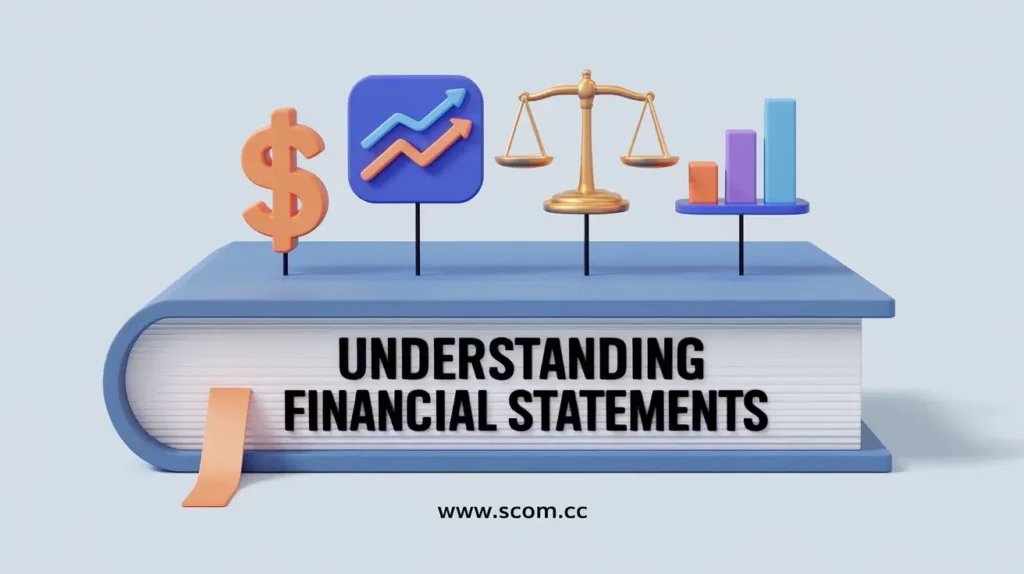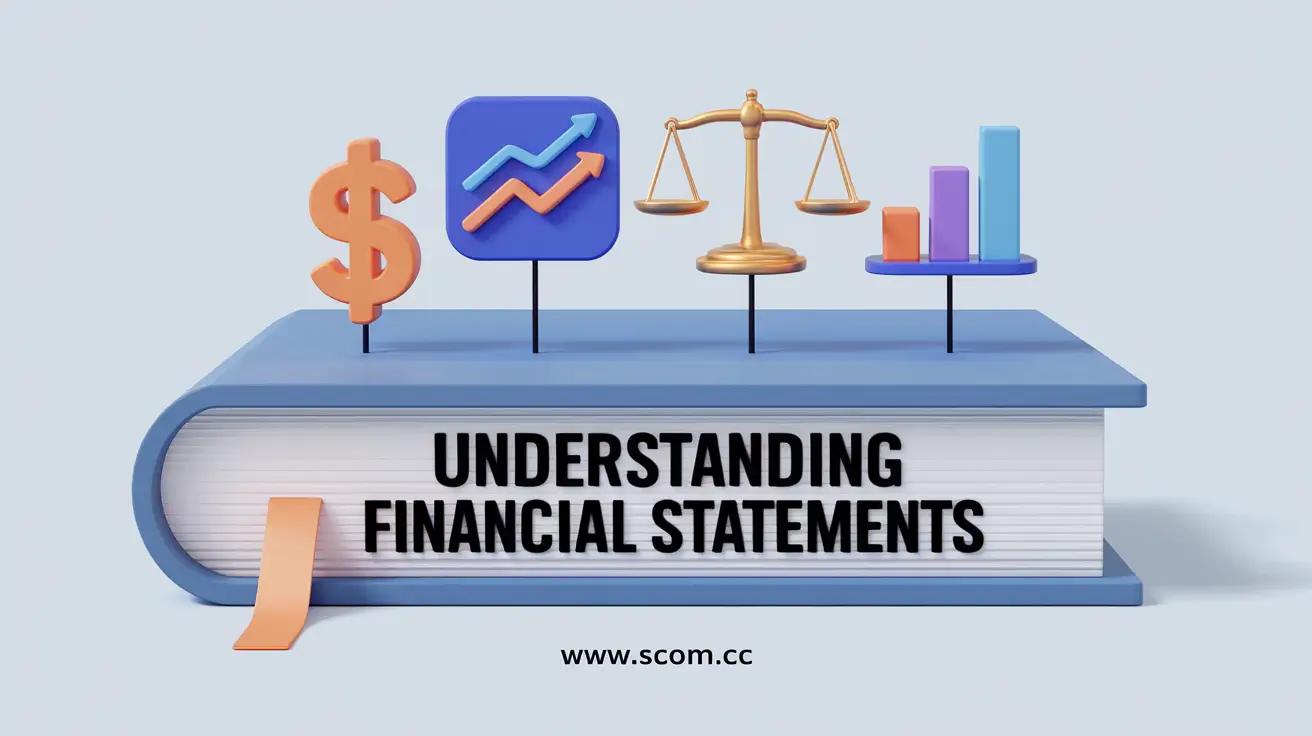Understanding Financial Statements

- Understanding Financial Statements: A Beginner's Guide
- Types of Financial Statements
- Key Components of Each Financial Statement
- How to Interpret Financial Statements
- Common Financial Ratios and What They Reveal
- Common Pitfalls and How to Avoid Them
- Summary Table
-
FAQ
- What are financial statements, and why are they important?
- What is the difference between the balance sheet and the income statement?
- How can I use financial statements to assess a company’s performance?
- What are some common financial ratios used in analysis?
- How do I interpret a company’s cash flow statement?
- What should I look for in the notes to financial statements?
- How often should financial statements be reviewed?
Understanding Financial Statements: A Beginner's Guide
Financial statements are essential tools for evaluating the health and performance of a business. They provide a snapshot of a company’s financial situation and help stakeholders make informed decisions. For beginners, understanding financial statements can be challenging, but with the right approach, it becomes more manageable. This guide will walk you through the basics of financial statements, including their types, key components, and how to interpret them.
Types of Financial Statements
Financial statements come in several types, each serving a specific purpose. The three primary financial statements are:
- Balance Sheet: Also known as the statement of financial position, the balance sheet provides a snapshot of a company's assets, liabilities, and equity at a specific point in time. It shows what the company owns and owes, as well as the shareholders' equity.
- Income Statement: Also known as the profit and loss statement, the income statement reports a company's revenues, expenses, and profits over a specific period. It shows how much money the company earned and spent during that time.
- Cash Flow Statement: This statement details the cash inflows and outflows from operating, investing, and financing activities. It provides insight into how cash is generated and used, which is crucial for assessing a company's liquidity.
- Statement of Changes in Equity: This statement outlines the changes in shareholders' equity over a period. It includes information on retained earnings, stock issuances, and dividends.
Key Components of Each Financial Statement
Balance Sheet
The balance sheet is divided into three main sections:
- Assets: Assets are everything a company owns that has value. They are classified into:
- Current Assets: Assets that are expected to be converted into cash or used up within one year, such as cash, accounts receivable, and inventory.
- Non-Current Assets: Assets that will provide value over a longer period, such as property, plant, equipment, and intangible assets like patents.
- Liabilities: Liabilities are obligations the company owes to others. They are classified into:
- Current Liabilities: Debts and obligations that are due within one year, such as accounts payable and short-term loans.
- Non-Current Liabilities: Obligations due beyond one year, such as long-term loans and bonds payable.
- Equity: Equity represents the owners' claims on the company’s assets after all liabilities have been settled. It includes:
- Share Capital: Funds raised from issuing shares.
- Retained Earnings: The portion of profits not distributed as dividends but reinvested in the company.
- Additional Paid-In Capital: Amount paid by shareholders above the nominal value of the shares.
Income Statement
The income statement is structured as follows:
- Revenue: The total income generated from sales of goods or services before any expenses are deducted.
- Cost of Goods Sold (COGS): The direct costs attributable to the production of goods sold by the company. This includes raw materials and labor costs.
- Gross Profit: Calculated as revenue minus COGS. It represents the profit earned before deducting operating expenses.
- Operating Expenses: Costs associated with running the business, including salaries, rent, and utilities. These are divided into:
- Selling Expenses: Costs related to sales and marketing.
- Administrative Expenses: Costs associated with the general administration of the business.
- Operating Income: Calculated as gross profit minus operating expenses. It represents the profit from core business operations.
- Other Income and Expenses: Includes non-operating items such as interest income, interest expenses, and gains or losses from asset sales.
- Net Income: The bottom line of the income statement, calculated as operating income plus/minus other income and expenses, minus taxes. It represents the company's total profit or loss for the period.
Cash Flow Statement
The cash flow statement is divided into three sections:
- Operating Activities: Cash flows from the primary business operations, including receipts from customers and payments to suppliers and employees.
- Investing Activities: Cash flows related to investments in long-term assets, such as purchasing or selling property, equipment, or investments.
- Financing Activities: Cash flows from transactions with the company’s owners and creditors, including issuing or repurchasing stock, borrowing, and repaying loans.
Statement of Changes in Equity
This statement includes:
- Beginning Equity: The equity at the start of the period.
- Additions: Changes such as additional share capital, net income, and other comprehensive income.
- Deductions: Changes such as dividends paid and share repurchases.
- Ending Equity: The equity at the end of the period, calculated as the beginning equity plus additions minus deductions.
How to Interpret Financial Statements
Interpreting financial statements involves analyzing the data to understand a company’s financial health and performance. Here’s how to approach it:
- Analyze Profitability: Review the income statement to assess profitability. Key metrics include gross profit margin (gross profit/revenue), operating margin (operating income/revenue), and net profit margin (net income/revenue).
- Evaluate Liquidity: Assess the company's ability to meet short-term obligations by analyzing the balance sheet. Key ratios include the current ratio (current assets/current liabilities) and quick ratio (quick assets/current liabilities).
- Examine Solvency: Determine the company’s ability to meet long-term obligations by analyzing debt levels. Key ratios include the debt-to-equity ratio (total liabilities/total equity) and the interest coverage ratio (operating income/interest expenses).
- Assess Efficiency: Analyze how efficiently the company uses its assets. Key metrics include asset turnover (revenue/total assets) and inventory turnover (COGS/average inventory).
- Review Cash Flow: Evaluate the cash flow statement to understand how cash is generated and used. Positive cash flow from operating activities is crucial for sustaining operations and growth.
- Compare with Industry Benchmarks: Compare the company’s financial metrics with industry averages to gauge performance relative to peers.
- Look for Trends: Analyze financial statements over multiple periods to identify trends and changes in performance. This can help predict future performance and detect potential issues.
Common Financial Ratios and What They Reveal
Financial ratios are used to assess various aspects of a company's performance and financial health. Here are some commonly used ratios:
- Liquidity Ratios:
- Current Ratio: Measures short-term liquidity by comparing current assets to current liabilities. A ratio above 1 indicates sufficient short-term assets to cover liabilities.
- Quick Ratio: A stricter measure of liquidity that excludes inventory from current assets. It indicates the ability to meet short-term obligations with the most liquid assets.
- Profitability Ratios:
- Gross Profit Margin: Shows the percentage of revenue that exceeds COGS. A higher margin indicates better profitability.
- Net Profit Margin: Represents the percentage of revenue remaining after all expenses. It measures overall profitability.
- Efficiency Ratios:
- Inventory Turnover: Indicates how often inventory is sold and replaced over a period. A higher ratio suggests efficient inventory management.
- Asset Turnover: Measures how effectively assets are used to generate revenue. A higher ratio indicates efficient asset utilization.
- Solvency Ratios:
- Debt-to-Equity Ratio: Compares total liabilities to shareholders' equity. A higher ratio indicates greater financial leverage and potential risk.
- Interest Coverage Ratio: Measures the ability to cover interest expenses with operating income. A higher ratio indicates better ability to meet interest obligations.
Common Pitfalls and How to Avoid Them
Understanding financial statements can be complex, and beginners often encounter common pitfalls. Here’s how to avoid them:
- Ignoring Notes to Financial Statements: Always review the notes that accompany financial statements. They provide essential details and context that are not included in the main statements.
- Overlooking Non-Recurring Items: Be aware of non-recurring items such as one-time gains or losses. These can distort the true performance of the business.
- Failing to Compare Periods: Analyze financial statements across multiple periods to understand trends and avoid making decisions based on a single period’s data.
- Not Considering Industry Benchmarks: Compare financial metrics with industry benchmarks to get a better sense of performance relative to peers.
- Misinterpreting Ratios: Understand what each ratio measures and use them in conjunction with other metrics for a comprehensive analysis. Avoid relying on a single ratio for decision-making.
Summary Table
| Topic | Key Points |
|---|---|
| Types of Financial Statements | Balance Sheet, Income Statement, Cash Flow Statement, Statement of Changes in Equity. |
| Key Components | Balance Sheet: Assets, Liabilities, Equity; Income Statement: Revenue, COGS, Operating Expenses, Net Income; Cash Flow Statement: Operating, Investing, Financing Activities. |
| Interpreting Financial Statements | Analyze profitability, liquidity, solvency, efficiency, and cash flow. Compare with industry benchmarks and review trends. |
| Common Ratios | Liquidity Ratios: Current Ratio, Quick Ratio; Profitability Ratios: Gross Profit Margin, Net Profit Margin; Efficiency Ratios: Inventory Turnover, Asset Turnover; Solvency Ratios: Debt-to-Equity Ratio, Interest Coverage Ratio. |
| Pitfalls and How to Avoid Them | Review notes, avoid overlooking non-recurring items, compare periods, consider industry benchmarks, and understand ratios. |
FAQ
What are financial statements, and why are they important?
Financial statements are reports that provide a summary of a company’s financial performance and position. They are important because they offer insights into the company’s financial health, profitability, and cash flow, which are essential for making informed business decisions.
What is the difference between the balance sheet and the income statement?
The balance sheet provides a snapshot of a company’s assets, liabilities, and equity at a specific point in time, while the income statement shows the company’s revenues, expenses, and profits over a period.
How can I use financial statements to assess a company’s performance?
You can use financial statements to analyze profitability, liquidity, solvency, and efficiency. Key metrics and ratios help evaluate these aspects and provide insights into the company’s overall performance.
What are some common financial ratios used in analysis?
Common financial ratios include liquidity ratios (current ratio, quick ratio), profitability ratios (gross profit margin, net profit margin), efficiency ratios (inventory turnover, asset turnover), and solvency ratios (debt-to-equity ratio, interest coverage ratio).
How do I interpret a company’s cash flow statement?
The cash flow statement provides insights into cash inflows and outflows from operating, investing, and financing activities. Analyze the net cash flow from each activity to understand how cash is generated and used.
What should I look for in the notes to financial statements?
The notes provide additional details and context about the financial statements, including accounting policies, contingent liabilities, and explanations of significant transactions. They are crucial for a complete understanding of the financial reports.
How often should financial statements be reviewed?
Financial statements should be reviewed regularly, ideally on a quarterly or annual basis, to monitor performance and make informed decisions. Regular reviews help identify trends and potential issues early.

If you enjoyed this article and found it valuable, we encourage you to explore our news and valuable information section, where you'll find more relevant and up-to-date content that may pique your interest. Additionally, if you are seeking advice or need guidance on a specific topic, we suggest visiting our services section. There, you will find a variety of options designed to assist and support you in addressing your needs. Feel free to check out both sections to get the information and assistance that best suits your requirements.

Leave a Reply